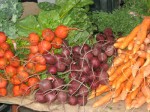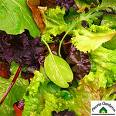
Radishes:
Lettuce:
Beets:
Fresh beets are a real treat and I plant them every year even though my clay soil only produces small ones. A golf-sized beet is a big for me; who eats a big beet in one bite anyway? The seeds are fairly large and easily planted.
Peas:
There are three kinds of peas, snow peas, snap peas, and English peas. The first two are the easiest to grow and can be eaten pod and all; English peas are more difficult to grow, have to be shelled, and take up more room in the garden. Any pea may have rot problems in cold moist soil but can be presprouted by putting the seeds in wet paper towels, then inside a zip locked plastic bag and given 70F degree bottom heat. In 4-5 days the peas will have sprouted and can (very) carefully be planted into the garden. This may sound a bit arduous but you will enjoy a wonderful treat from the vines and it will all be worth it. ( P.S.Lettuce is a good crop to plant with peas)
Carrots:
Peter rabbit liked carrots and so will you when you harvest finger sized ones right out of your garden. Carrot seeds, like those of its relatives, parsley and parsnip take a long time (20 days) to germinate and cannot dry out during that time. To hasten germination and harvest sooner mix the seeds with a handful of damp peat moss. Spread the mixture on paper or cardboard, place in a ziplocked plastic bag, and put into the freezer for 24 hours. Remove the peat filled bag from the freezer and give it bottom heat of 70F for 3 or 4 days until the seeds sprout. Once the seeds have sprouted, spread the seeds and moss in the garden, cover with fine soil, and water well until the sprouts emerge from the soil. There are many different kinds of carrots so try a mix and stagger the sowing to get a prolonged harvest.
Other cold weather veggies include broccoli, cauliflower, brussel sprout, and cabbage and celery. Growing these from seed is more time consuming than the seeds mentioned above and many people buy seedlings.
